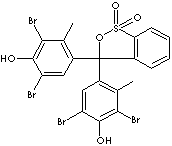PRODUCT IDENTIFICATION
3.8 - 5.4

EINECS NO.
SMILES
C1(c2c(cccc2)S(O1)(=O)=O)(c1c(c(c(O)c(c1)Br)Br)C)c1c(c(c(O)c (c1)Br)Br)C
CLASSIFICATION
Indicator
EXTRA NOTES
An indicator and reagent. It has been used in serum albumin determinations and as a pH indicator.
Other RN: 641-19-0
PHYSICAL AND CHEMICAL PROPERTIES
sparingly soluble in water (soluble in benzene, and very soluble in ethanol and diethyl ether)
AUTOIGNITION
REFRACTIVE INDEX
APPLICATIONS
- alpha-Naphthol phthalein (CAS #: 596-01-0): from pH 7.3 (pinkish-yellow) to pH 8.7 (greenish-blue)
- Bromocresol green (CAS #: 76-60-8): from pH 3.8 (yellow) to pH 5.4 (blue)
- Bromcresol Purple (CAS #: 115-40-2): from pH 5.2 (yellow) to pH 6.8 (purple)
- Bromochlorophenol Blue (CAS #: 2553-71-1): from pH 3.2 (yellow) to pH 4.8 (blue)
- Bromocresol purple, sodium salt (CAS #: 62625-30-3): from pH 5.2 (yellow) to pH 6.8 (purple)
- Bromophenol blue (CAS #: 115-39-9): from pH 3.0 (yellow) to pH 4.6 (blue)
- Bromophenol blue, sodium salt (CAS #: 62625-28-9): from pH 3.0 (yellow) to pH 4.6 (blue)
- Bromopyrogallol Red (CAS #: 16574-43-9): suitable for complexometric or chelometric titrations
- Bromothymol blue (CAS #: 76-59-5): from pH 6.0 (yellow) to pH 7.6 (blue)
- Bromothymol blue, sodium salt (CAS #: 34722-90-2): from pH 6.0 (yellow) to pH 7.6 (blue)
- Bromoxylenol Blue (CAS #: 40070-59-5): from pH 6.0 (yellow) to pH 7.6 (blue)
- Chlorophenol Red, water soluble (CAS #: 123333-64-2): from pH 4.6 (yellow) to pH 7.0 (purple)
- Cresol Red (CAS #: 1733-12-6): from pH 7.0 (orange) to pH 8.8 (purple)
- Fluorescein (CAS #: 2321-07-5)
- Fluorescein sodium (CAS #: 518-47-8):
- Glycinethymol Blue (CAS #: 3810-63-7):
- Iodophthalein sodium (CAS #: 2217-44-9)
- m-Cresol purple (CAS #: 2303-01-7): from pH 7.4 (yellow) to pH 9.0 (purple)
- Methylthymol blue, sodium salt (CAS #: 1945-77-3): suitable for complexometric or chelometric titrations
- o-Cresolphthalein (CAS #: 596-27-0): from pH 8.2 (colorless) to pH 9.8 (red)
- o-Cresolphthalein Complexone (CAS #: 2411-89-4): suitable for complexometric or chelometric titrations
- Phenolphthalein Complexone (CAS #: 25296-54-2):
- Phenol Red (CAS #: 143-74-8): from pH 6.8 (yellow) to pH 8.2 (red)
- Phenol Red Sodium Salt (CAS #: 34487-61-1): from pH 6.8 (yellow) to pH 8.2 (red)
- Phenolphthalein (CAS #: 77-09-8): from pH 8.5 (colorless) to 9.0 (red)
- p-Xylenol Blue (CAS #: 125-31-5):
- Acid range: from pH 1.2 (red) to pH 2.8 (yellow)
- Alkali range: from pH 8.0 (yellow) to pH 9.6 (purplish-blue)
- Pyrocatechol violet (CAS #: 115-41-3): suitable for determination of many metals (complexometric or chelometric titrations) particularly rapid for tin
- Pyrogallol Red (CAS #: 32638-88-3):
- Thymol Blue, sodium salt (CAS #: 62625-21-2):
- Acid range: from pH 1.2 (red) to pH 2.8 (yellow)
- Alkaline range: from pH 8.0 (yellow) to pH 9.2 (blue)
- Thymolphthalein Complexone (CAS #: 1913-93-5): suitable for complexometric or chelometric titrations
- Thymolphthalein (CAS #: 125-20-2): from pH 8.8 (colourless) to pH 10.5 (blue)
Phthalein is the moiety in a dye which shows color changes depend on particular hydrogen ion concentrations. Certain phthaleins (e.g. phenolphthalein) have a cathartic action.
Bromocresol Green, 3',3'',5',5''-Tetrabromo-m-cresolsulfonephthalein, is a pH used as an indicator form pH 3.8 (yellow) and 5.4 (blue). It is a brown powder sparingly soluble in water, soluble in benzene, and very soluble in ethanol and diethyl ether. The sodium salt is a dark green powder. Both of free acid and sodium salt are used as pH indicator. It was used in serum albumin determinations. Bromocresol Green is used in oil field industry for alkalinity test of mud filtrate. Bromocresol Purple is 5',5''-Dibromo-o-cresolsulfonephthalein, a yellow powder soluble in water. The pH range is from pH 5.2 (yellow) to pH 6.8 (purple). Bromophenol red (CAS RN: 2800-80-8) is 5',5''-Dibromophenolsulfonphthalein, a brown powder with pH range from 5.2 (orange-yellow) to pH 6.8 (red)
APPEARANCE
95.0% min
LOSS ON DRYING
5.0% max
CLARITY OF SOLUTION
pass
pH 3.8 (yellow) and 5.4 (blue)
HAZARD OVERVIEW
GHS (Globally Harmonised System) Classification: Not a dangerous substance. Potential Health Effects: Eyes - May cause eye irritation. Skin - May be harmful if absorbed through skin May cause skin irritation. Inhalation - May be harmful if inhaled. May cause respiratory tract irritation. Ingestion - May be harmful if swallowed.
RISK PHRASES
36/37/38
SAFETY PHRASES
26-36
PRICE INFORMATION